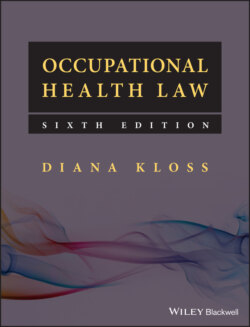Читать книгу Occupational Health Law - Diana Kloss - Страница 28
Good work is good for you
ОглавлениеIn 2006 a further strategy document was published by the government: Health, work and well‐being – caring for our future. In the new century the emphasis had shifted from the importance of protecting the health of workers to the need to reduce the numbers of claimants on incapacity benefit. Rehabilitation was the new mantra. Central to this philosophy were the results of the report of Gordon Waddell and Kim Burton: Is work good for your health and well‐being? (2006). Their answer was strongly in the affirmative. Their research demonstrated that those in work are on the whole healthier than the unemployed and that the longer a worker is absent sick from the workplace the less likely they are ever to return to work. It is not merely a financial issue: social interaction and a feeling of self‐worth are also important. The strategy combined both occupational and public health for working people. Dame Carol Black was appointed national director for work and health in 2006 and in 2008 produced her seminal review of the health of Britain’s working age population: Working for a healthier tomorrow (Black Report). Based on a specially commissioned report by PricewaterhouseCooper, the review stated that investment by employers in well‐being was rewarded by lower rates of sickness absence, staff turnover, accidents and injuries, alongside improvements in employee satisfaction, company profile, and productivity.
Based on Waddell and Burton’s findings, the review counselled that both employers and workers needed to have a fundamental change in attitude and to realise that people do not need to be 100 per cent fit in order to be at work. Employers should maintain early, regular and sensitive contact with employees to promote return to work and should be proactive in making contact with GPs when an employee was off sick. GPs were central in shaping patients’ views about their ability to work. ‘Despite their best intentions, the advice that healthcare professionals give to their patients can be naturally cautious and may not be in the best interests of the patient for the long term.’
Statistics showed that although the majority of people returned to work relatively quickly after starting a period of sickness absence, a significant minority were off sick for much longer and might eventually progress to worklessness. A patient with back pain whose condition had not resolved quickly might be referred for physiotherapy, and while they were waiting for treatment would continue to be signed off from work by the GP. The review found that early intervention by occupational health services could play a key role in assessing how and when employees could return to appropriate work. They should adopt the ‘biopsychosocial’ model which links the medical condition with its impact on mental health and also its social context. Access to cognitive behaviour therapy for mental health problems had been proved to be particularly effective. The report recommended the creation of a Fit for Work advisory service, provided through the NHS.
As regards the role of occupational health in the new climate, Dame Carol pointed to a number of challenges. The historical separation of occupational health from mainstream health care failed to meet current needs for holistic support. The NHS now needed to move from providing occupational health services only for its own staff, to all the population of working age, whether or not they were actually in work. There needed to be clear standards of practice and formal accreditation for all occupational health providers, a sound academic base to provide research and support, the systematic gathering and analysis of data, and a universal awareness and understanding of the latest evidence of the effectiveness of clinical interventions. Not only that, measures were needed to address the uneven provision of occupational health, especially for workers in SMEs. Advice and information should be more widely available, particularly to small businesses.
The Black Report was criticised for its sparse attention to health and safety, with little mention of risk assessment and enforcement of health and safety legislation. Intervention should be about changing the workplace so that the worker does not become a patient in the first place. But it should be said that the reports and programmes from the HSC/HSE, as set out above, had already dealt with these issues. Up until the Black Report insufficient attention had been paid to rehabilitation, not just for work‐related disease and injury but also for those workers with a disability whose health problems are unrelated to their work, but are prevented from working because of them. At the same time there has been a demographic shift whereby people are living longer and the proportion of the population over retirement age, compared with those of working age, is therefore increasing; it is now necessary for people to work to a greater age in order to support themselves. Older workers are more likely to be living with chronic health conditions and to need occupational health support.
The government published its response to the Black Report in November 2008: Improving Health and Work: Changing Lives (DOH, 2008). It included some ambitious plans but, sadly, the publication of the response coincided with the beginning of an economic recession which led to a period of austerity when public spending was savagely restricted.
A second independent review was commissioned by the government, this time authored by Dame Carol Black and David Frost: Health at Work: an independent review of sickness absence (2011). The government’s response: Fitness for Work: the Government response was published in 2013.
Then, in 2016, the UK voted by a small majority in a referendum to leave the European Union and the resultant political turmoil occupied much of the time of Parliament, the government and the civil service. The second decade of the 21st century proved one of the most testing times in the history of the UK since the end of World War II.
